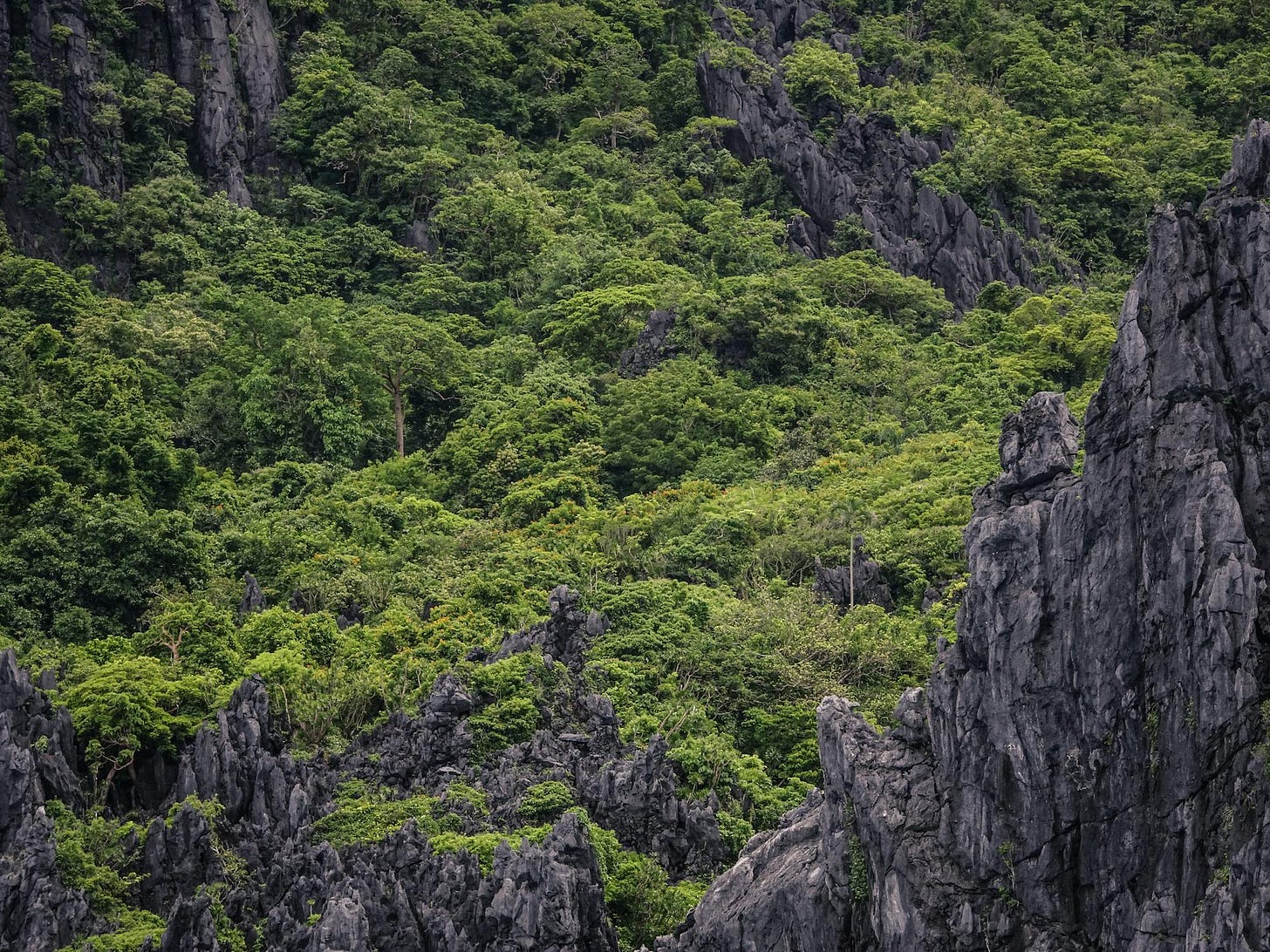What are Key Biodiversity Areas?
A concise explanation of Key Biodiversity Areas, an illuminating example of how science can inform policymaking.
KBA is short for Key Biodiversity Area, e.g. one of a select number of reefs, forests, swamps, and other areas that hold outsize importance for the continued flourishing of life on our planet. I started working with KBAs last year, as part of my first job as a research associate in my old university. Back then, friends and family always asked what I did for a living. As a reply I would often shrug, scratch my head, and say, with a hint of a question in my own voice, “I do research on KBAs?” Since then, I’ve gathered a touch more experience, and learned a bit more about how science informs and influences decision-making, to give a hopefully better explanation of the work I’m still doing. What follows is my belated answer to that all too difficult follow-up question: “Then what on earth are KBAs?”

Life as we know it is under siege. Scientists estimate that wildlife populations have fallen by around 70% since the middle of the last century. More than 80% of cycads, an ancient taxon dating to time of the dinosaurs, face imminent destruction. Butterflies are dying, bees disappearing, even flies are vanishing.
It’s in this disastrous context of widespread ecological collapse that biologists, contending with scarce resources and funding, have been trying to pinpoint the most vital refuges of biodiversity still left, that we might better act to prevent the disintegration of our shared biosphere. But where might these refuges be found? And how might they be located?
Enter KBAs: Key Biodiversity Areas.
Last 2004, members of the International Union for the Conservation of Nature (IUCN) agreed on the need for a shared “methodology to enable countries to identify key biodiversity areas.” In other words, experts and policymakers around the world wanted to come up with a common set of rules and procedures that would let anyone, from any nation, highlight areas that are crucial for the continued survival of species and the habitats they live in. These efforts would eventually lead to the 2016 publication of A Global Standard for the Identification of Key Biodiversity Areas, or the KBA Standard, which formally defines KBAs as “sites that contribute significantly to the persistence of biodiversity.”
Significance here refers to a set of objective, transparent, and globally applicable criteria, which are meant to capture the different ways a site may be important for biodiversity. These criteria usually involve quantitative thresholds about estimated population size, e.g. the number of individuals of a certain species present at site. If a site meets one or more of these criteria, then it’s a KBA. If not, then it isn’t a KBA.
These criteria form an integral part of the KBA Standard. Understanding them will help clarify what KBAs are and their significance to the world around us.

Criterion A: Threatened Biodiversity. Sites trigger Criterion A if they hold a significant proportion of the global population of a threatened species. Think orangutans or pandas. Because of the danger these species face, these population size thresholds can be quite small. If a site holds just 0.5% of the global population size of even one critically endangered species, for example, like the Philippine Eagle, then it would trigger Criterion A. For the alarmingly imperiled Philippine Eagle, the presence of five breeding pairs in a forest (e.g. five males, five females) would be enough to trigger KBA status.
Criterion A sites are important because they are usually the last havens for species at great risk of extinction. If these sites disappear, the species they contain will likely vanish as well.
Criterion B: Geographically Restricted Biodiversity. Some species are geographically restricted: they occur in only a few locations. Because they’re found over such small spaces, they’re often threatened species, but not always. A species is geographically restricted to a site if the site holds 10% or greater of the global population of a species; just one such species is enough to trigger KBA status. The species Dillenia sibuynanensis, also known as the Sibuyan Katmon, a flowering plant graced by shining yellow petals, is found only in Mt. Guiting-Guiting, Sibuyan Island. Because Mt Guiting-Guiting essentially holds 100% of the plant’s global population, it qualifies as a KBA under Criterion B.
Just like Criterion A sites, if Criterion B sites disappear, the species they contain will probably be eradicated. If Mt. Guiting-Guiting were to be completely logged, then the malakatmon would go extinct forever.
Criterion C: Ecological Integrity. Think of vast tracts of forest where streams continue to run unbroken, and the only sign of industry is the rare passenger plane soaring distantly overhead. These sites represent the last areas in the world where large-scale ecological processes, like forests breathing in atmospheric carbon, are still mostly intact. In the Philippines, the as yet mostly verdant Sierra Madre mountain range may be one of the few locations that can fit such an increasingly rare description.
Unlike the previous two criteria, assessing a site for Criterion C is more complex. It involves not just quantitative thresholds, but also dedicated consultation with scientists and indigenous experts, computer modelling, historical studies, and other forms of intensive research. That said, the effort may be worth it. The Sierra Madre is irreplaceable; to remake an ecosystem of that size and scale would take hundreds of thousands if not millions of years.
These are three of the five main criteria that form the backbone of the KBA Standard. Criterion D deals with things like demographic aggregations, such as emperor penguin colonies, where thousands of adults gather to breed their young each year. Criterion E involves obscure and rarely used statistics that is best not mentioned here. To outline the workings of the last two criteria, as well as the complexities of all the various sub-criteria, would take far too many pages to explain in a timely manner. (For example, while I explained the criteria above mostly in terms of species, they also apply to ecosystems. Many people are familiar with the IUCN Red List of Threatened Species, but I’d bet few realize that a similar Red List of Threatened Ecosystems exists as well.)
What’s important is to realize what KBAs represent, as sites “important for the persistence of biodiversity.” These are the areas where hundreds and hundreds of distinct forms of plants, animals, insects, worms, and fungi yet survive on an increasingly scarred planet, where the ancient cycles of growth and decomposition continue unabated against the burning ravages of industrial greed and overconsumption. The last citadels of life stand in KBAs. We lose them at our peril.
As a sort of epilogue to this article, it’s also good to realize that because the KBA Standard is meant to fit as much of the globe as possible, it’s not always perfect at matching every scenario. The document is being constantly refined. At a recent workshop, for example, several scientists pointed out that the formal definition of a ‘range-restricted species’ in the KBA Standard – e.g., one which occurs over a space less than 10,000 square kilometers – doesn’t fit well in the Philippines. Because for an archipelagic country like the Philippines, where every sizeable island has at least one mountain with at least one unique species that occurs there and only there, essentially every island of note would have a ‘range-restricted species.’ How effective would a prioritization scheme like the KBA Standard would be if basically everything is a priority?
These contentions may sound trivial to some, but to me at least, they serve as an illuminating example of how science informs and influences policymaking. I imagine similar negotiations, with the same kind of almost pedantic quibbling over definitions, played an important part during the behind the scenes of every report released by the Intergovernmental Panel on Climate Change (IPCC).
Because strictly speaking, KBAs are not protected areas. They have no legal standing. Instead, they serve as more of an advisory tool. As the outputs of a rigorous, scientific process, KBAs help businesses, governments, and local communities understand why some areas are particularly important for biodiversity, and why these areas would likely be good targets for priority research and conservation. That’s their role; that’s their power. If you have any interest in conservation, it would probably be helpful to have some idea of what KBAs are, what they mean, and what, with proper stewardship, they can eventually be.



